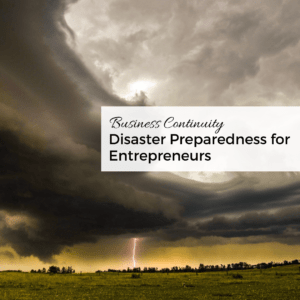- +1 512-591-8295
- [email protected]
- Mon - Fri: 9:00 - 16:00
- +1 512-591-8295
- [email protected]
- Mon - Fri: 9:00 - 16:00

When running a small business or working as a solopreneur, disaster preparedness is crucial yet often overlooked. And as I found out, even when you think you’re prepared, something may come along that stretches beyond what you’re ready for. Our recent experience with hurricane Beryl highlighted the importance of being ready for extended disruptions – those that go on for much longer than you would expect. Let’s explore practical strategies and lessons learned to help your business remain resilient in the face of unexpected challenges.
Being prepared for a disaster goes beyond having a plan; it requires thorough testing and real-world adjustments. I believed I was ready for hurricane Beryl. In addition to preparing emergency food and water, plus downloading some shows on my iPad and making sure that every device was fully charged, and I had plans to mitigate work interruptions.
Yes my husband thought I was silly to have a case of emergency food rations, water filtration straws, tabletop mini fire pits (we’re strictly limited by our condo association), and multiple collapsible 5-gallon water containers. I even bought a rechargeable fan that could be charged up from either my solar battery bank or my vehicle (after all, it gets hot in Houston).
I was a good Girl Scout … I know how to be prepared.
My work plans had been well tested over the past couple of years, and I already knew what tasks I could handle using only my cell phone, or using my mobile hotspot tethered laptop or tablet. However, the reality of the disaster exposed significant gaps in my preparations.
But …
Despite extensive preparations—stocking up on water and food, having a super solar-powered charger, and setting an indefinite out-of-office email—unforeseen challenges arose.
We travel to Puerto Rico often, and were well aware of the issues the island can struggle with after a major hurricane with extended outages of water and power. However, living in Houston – the fourth largest city in the US – and one of the largest in the world. Past hurricanes have meant relatively short power outages in the past, so we weren’t very worried, especially considering that it was projected that the city would only be getting the fringe rain and winds.
But the storm turned, and Houston was hit with the eye. The electricity was completely off for ten days, affecting not just my home but the entire city … so it’s not like you can just run down the street to Starbucks or a co-working space because none of them had electricity either. Infrastructure and equipment was damaged across the entire region. And of course, no electricity also means no internet.
Even after power returned, the internet was still down for several more days, and when it did come back, it was slow (like 1/4 the speed we should get) and unreliable. Trying to use my mobile hotspot was also nearly impossible since tens of thousands of other people without electricity and internet were trying to do the same thing at the same time, overcrowding the networks.
These extended disruptions revealed the necessity of an even more robust disaster plan.
Before diving into some of the insights I learned, it’s essential to highlight some proactive measures I already had in place that helped mitigate the impact:
Disasters come in many forms and can have varying impacts on your business. Some may only cause temporary disruptions, like a brief power outage, while others, like a hurricane, can result in prolonged interruptions.
Being prepared for both short-term and long-term disruptions (longer than you might think) is crucial to maintaining business continuity.
Based on my experience with Hurricane Beryl, here are five actionable tips to ensure your business is prepared for a disaster that lasts longer than you expect:
To further enhance your disaster preparedness, consider the following components:
Disaster preparedness for small businesses and solopreneurs is not just about having a plan but ensuring that plan is robust, tested, and adaptable. By learning from real-world experiences and implementing these tips, you can enhance your resilience against prolonged disruptions. Remember, the key is to be proactive, flexible, and always ready to adapt to new challenges.
Get the marketing advice I share with my entrepreneur friends ...
... right in your inbox

Get solid marketing strategies, designed for entrepreneurs on the track to 7-figures and beyond, right in your inbox.

This website uses cookies to ensure you get the best experience on our website. By continuing to use the website, you agree to our use of cookies. We do not share or sell your information. More info
